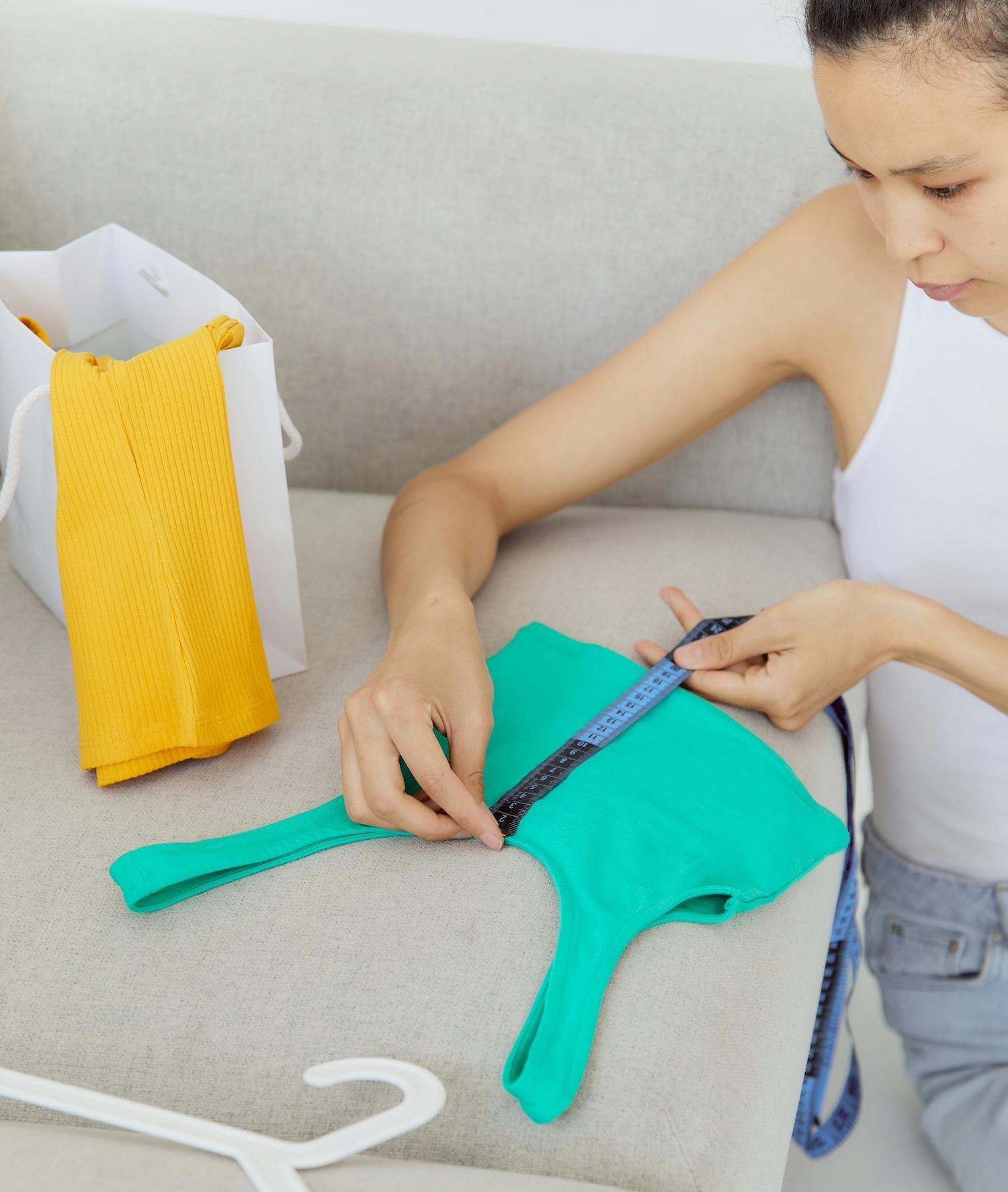
Editorial: Why garment measurements matter to vintage shoppers — and to the secondhand market
Online thrifters know that inconsistent information and missing measurements can make or break a buy. To continue encouraging the secondhand-shopping shift away from regular retail, clothing resellers need to measure up
I’ve been hunting for a dress to wear to a formal wedding for the past few weeks, and it’s got me thinking about something that’s broken in the way we shop for secondhand clothes.
First, some context: I don’t care about the numbers on the tag, but I do care about fit. Depending on the brand, I wear garments with tags ranging from size large to 2X, 14 to 18.
No matter what size you wear, you, too, likely have a range of tag sizes in your closet.
Like most people, I have preferences when it comes to the colours and styles I wear, especially at certain times of year.
And when I’m seeking something specific, like this wedding-guest dress that has quickly turned into a bigger search-and-rescue effort than I anticipated — though I’m not sure why, since this isn’t my first time valiantly searching for a secondhand special-occasion outfit — I tend to shop online.
When I have a few minutes to stop vintage business-ing and turn to vintage shopping, I scroll through all my usual haunts — Poshmark, Etsy, eBay, Depop, TheRealReal, thredUp, a handful of reseller websites that specialize in garments for my body type, and the online inventory at a fabulous rental shop here in Toronto (where I’m based) called The Fitzroy.
I can’t spend the time required to crisscross our gridlocked city peeking into thrift and vintage stores that may or may not have something I’m interested in, let alone in a size that will fit me, when I’m on a deadline.
Despite how we may want to shop, people in the mid-size and plus-size communities don’t always have the luxury of finding something secondhand when there are parameters like dress code, sleeve style, length, material, colour, weather, fit and budget in the mix alongside size.
So I always try secondhand first. Every time I’m on the hunt before an event, I start early and leave myself lots of time to conduct an exhaustive search before I consider newly made options.
But boy, many of these marketplaces and shops do not make it easy.
Measuring up the inventory
Any thrifter worth their hard-won grail knows that measurements are our best friend when shopping online.
Using a chest-waist-hip measurement rather than tag sizes means we make better purchase decisions. We keep more of what we buy, because there’s less chance of receiving an ill-fitting item and having to return or resell it.
Shopping with measurements in mind is a more sustainable way to shop, full stop. There’s no hiding. If the size chart says the shirt is four inches smaller than your chest measurement, the shirt isn’t going to magically stretch across.
There’s no delusion when you’re armed with your chest-waist-hip and a size guide, only data. Save yourself the time and the money and let it go. On to the next.
But if you’ve ever browsed for vintage and secondhand fashion online, you will know that oftentimes, there is limited information available to the buyer about fit.
Maybe you’ll get a “fits like a small” or “tagged XL.” If you’re really lucky, you’ll get a “tagged US 6” or “tagged UK 20.” The holy grail, of course, is the chest-waist-hip in centimetres or inches.
If a listing doesn’t contain exact measurements, but you know the brand of the secondhand garment and the tag size, you can look up the manufacturer’s size charts (assuming they’re still in business) and compare your own digits.
Or you can directly message a seller to ask for measurements — most are happy to oblige in my experience.
Maybe you’re on a secondhand shopping platform that includes what appear to be exact measurements, but there’s a major discrepancy between them and the tagged size shown on the garment. (More on this below.)
In all cases, you need to be a seasoned enough secondhand shopper to know to dig deeper. To bother to do it. To want to do it. We’re talking extra steps.
If I know anything about humans, it’s that we want the easiest path, almost every time. As the buyer, are you going to take the time to further investigate, or are you going to lose interest and bounce?
Most online clothing purchase decisions happen when we’re sitting alone on our couch half-watching Love it or List It. We read the item description, maybe we read a few reviews, we look at the size. Maybe we think about it for a little while and add it to our cart to hang out, but so often it’s just a split-second choice. Yes or no.
Some of us will care enough about shopping secondhand to unearth the measurement info if we need it. But wouldn’t it be easier if the details were just on the listing to begin with?
I don’t have hard data, but I suspect that both incomplete and incorrect information on secondhand listings are stifling sales. There isn’t an easy way to track this — abandoned carts aren’t enough if the user never puts the item into the cart in the first place.
There’s certainly anecdotal evidence, and I can say that as a buyer, my frequent hesitation to buy a measurement-less garment prevents me from making a purchase. In this economy, I’m not buying things I’m not pretty certain about. Now multiply me by all the others who might think like me.
If incomplete and incorrect information aren’t affecting the number of goods a vendor can move, they’re at the very least antithetical to the very thing that unifies so many vintage and secondhand sellers: We’re not like the big guys.
Small business is best for a reason: Buyers get direct attention. Incomplete and incorrect should be left to companies that care more about volume than they do their customers.
The limits of limited information
If you’re a clothing vendor reading this and you don’t already provide measurements, I know what you might be thinking. “It takes too long to measure every garment for every listing.” Or, “buyers don’t read anything anyway.”
I hear you, and I sympathize. There will always be people who don’t thoroughly read a listing no matter how much information you provide them.
But what if not including measurements is leaving money on the table and your inventory sits unsold longer than it needs to? What if you raised the price by a couple bucks to account for the three minutes you spend measuring a chest-waist-hip?
Clothing in general varies so much between sizes, let alone vintage garments that use outdated sizing systems. Someone browsing an online shop doesn’t have the option to slide a shirt over their heads or wiggle their butt into a pair of pants to test for fit.
Unless you’ve got the exact proportions of a fit model (the people whose bodies are used as a standard by manufacturers to determine fit), garment measurements are kind of the bare minimum for shopping online.
As a buyer, the listings that have me adding-unhesitatingly-to-cart either list the measurements in the description or include a photo of the garment laying flat with soft measuring tape laid across the waist, hip and chest.
Continued below
Find secondhand shops and services near you
Browse our directoryContinued from above
When I was doing background research for this article, I encountered a Reddit post from a seller complaining about an item that had been marked men’s large and a buyer who’d asked for further information to clarify if it was a US 10, 12, 14, etc.
I marvelled at the comments from sellers calling out the buyer for the question because men’s sizes don’t use numbers like women’s sizing does. Granted, the buyer did not articulate their request clearly, but I understood what they were asking.
Size large to someone who wears a size large is somewhat meaningless, because there’s still a good chance of that garment not fitting, particularly if you are big- or broad-chested or if you have a curvier midsection.
It comes from a place of privilege if you can say “fits like [insert size]” or “tagged [insert size]” and then fit every garment tagged as that size. It means your proportions are close to a fit model.
The buyer was hoping if they got a number, they would have a better idea of the likelihood of the item fitting. (What they actually needed to ask for were the exact measurements, but perhaps they didn’t know that.)
Measurements are what that buyer would receive if they visited any “firsthand” or traditional retailer’s website. Every manufacturer has a size chart so consumers can compare the tag size to chest-waist-hip in centimetres and inches before they make their purchase decision.
If we want buyers to consider secondhand as a replacement rather than a merely a sometimes-maybe alternative to new goods, especially when it comes to fast fashion, we need to offer it as one using the same tools of the trade that manufacturers do. Measurements. Link to size charts when available. Photos of tags if the garments still have them.
The rise of incorrect information
There’s another thing working against people shopping for secondhand clothing. As online marketplaces incorporate AI tools into their platforms, there’s more incorrect information popping up in listings, further befuddling buyers.
In my wedding-guest dress quest, I wound up on The RealReal, a luxury consignment platform that uses its own sizing system.
The marketplace is a bit different in that individual sellers do not control the listings. They consign with the platform, meaning they mail in their inventory and The RealReal’s team puts together the listings in a way that is both highly controlled and curated. When the item sells, the vendor who provided the inventory gets a cut.
The RealReal uses its own size chart. Garments are issued a size between XS and 5XL that best matches the item’s tag, but those numbers are not necessarily an exact translation of what’s on the tag.
For example, an item labelled M on The RealReal is a US 6-8. Not super helpful for a buyer, because those are different sizes. Expecting one and getting the other could be the difference between a garment fitting or not, especially if you’re shopping for a dress, blazer or pants.
Most listings do not include their actual tag information. Most listings also do not include a photo of the tag on the garment for the buyer to check.
As I dug deeper, I noticed discrepancies. The RealReal’s size chart indicates an XXL is a US16 and a 3XL is an 18-20. (Confusing for buyers, because in the plus size system, 3X exists and it’s not the same as The RealReal’s 3XL.)
I searched for a particular brand (Mac Duggal, if you’re curious), and used the few listings that happened to list their US tag equivalents to confirm that a listing for this brand labelled 3XL meant it was most likely a US 18 on the manufacturer’s size chart.
Since it’s up to The RealReal to decide which size category the garment belongs to and many of those categories are buckets of two sizes, I couldn’t be totally sure about my conclusion. The garment could be a 20.
So like any good online shopper, I checked the “estimated item measurements” on the listing.
I was surprised to find that a dress listed as 3XL (aka US 18-20) had listed a bust measurement of 38”, waist of 39.25” and hip of 44.75”.
According to The RealReal’s size chart, a 3XL should have a bust of 44-45”. And according to the original manufacturer’s size chart, the measurements for a US 18 should be 48” bust, 42” waist and 51” hip.
A 3XL, for argument’s sake, is a XXXL, or a 1X by another name. Anyone who wears a 1X in most any brand will know that a 38” bust measurement is far below the average for that tag size. Once again, I checked the original manufacturer’s size chart, which showed a 38” bust as a US 8 or medium.
That’s a pretty big jump from US 18.
Is your head spinning yet? Now imagine being the buyer trying to sort through all this.
Why are the measurements so off? I wondered. I emailed support and they requested a specific item number to confirm measurements (even though the measurements were incorrect on dozens of listings I opened).
Their staffer returned with the actual numbers on the garment I asked about, and they were close to the manufacturer’s: 46” bust, 40.5” waist, 48” hip.
I suspect AI software is used to estimate the measurements based on the image of the garment, but I don’t have confirmation on that (I’ve contacted their press team). It’s the only thing I can think of that would account for a six- to eight-inch difference in some cases, and it explains the use of the word “estimated.” But an eight-inch difference is not a rounding error.
The fashion and accessories on The RealReal are not exactly inexpensive. Buyers are looking at investing in these pieces, and they can’t even get a definitive on size (there’s the illusion they can, because there are measurements listed. They’re just not all correct!).
The RealReal offers returns on some items, a service that many secondhand shops don’t provide. So as a buyer, there is some comfort in knowing that if the fit is wildly off, you could ship it back.
But it shouldn’t be so off in the first place. And, by its nature, the secondhand market shouldn’t be encouraging returns. It’s supposed to be the more “sustainable” option, after all.
So what’s a buyer to do? Well, they might bounce. If they need to shop by measurement like I do, they might give up long before me and head on over to Anthropologie or Azazie or ASOS or H&M or wherever they can readily get something in their size, new, and compare it against a reasonably reliable size chart.
Until the secondhand market makes online shopping just as straightforward as traditional retail, the chasm between the two won’t fully close for shoppers who are looking for ease and expediency.
The big retailers may not think this is a big deal — The RealReal saw over 433,000 new buyers on the platform in 2024 — but for a small, independent resale business, continually making adjustments that improve customer experience, like providing exact measurements on online listings, is the way to keep them coming back.
Secondhand vendors often pride themselves on being the opposite of new, and on doing things differently than corporations. But this is one case where we can look to what manufacturers are doing and follow (well-measured) suit.
Thank you for valuing our work!
Support our work to see this page.
You’ve got a good eye, but this gem is only available for members. Register for a plan or upgrade your current one to peek behind this vintage curtain, or log in below.














